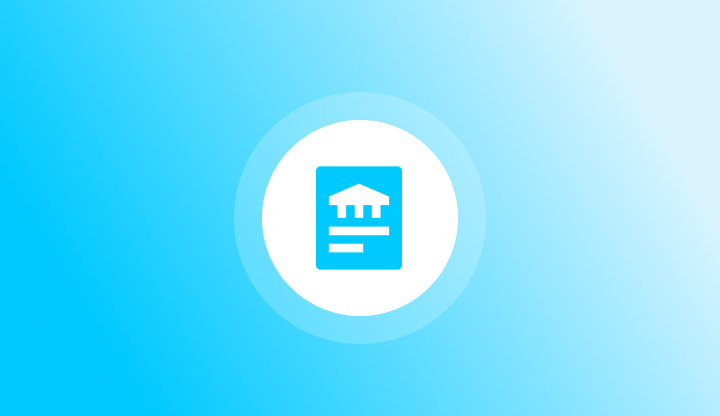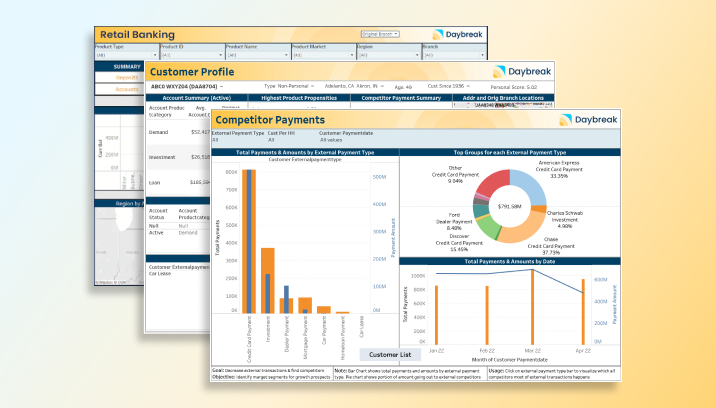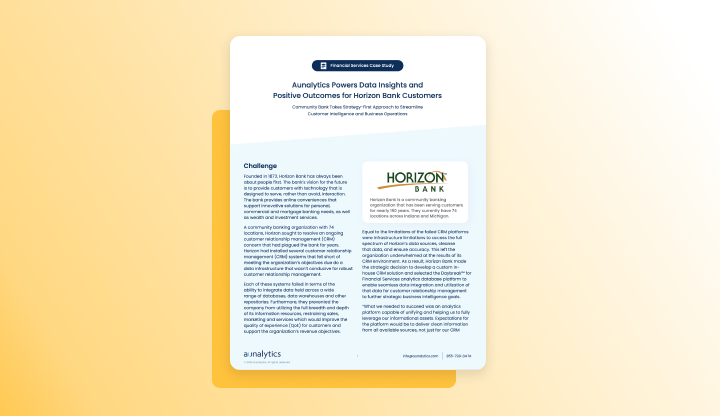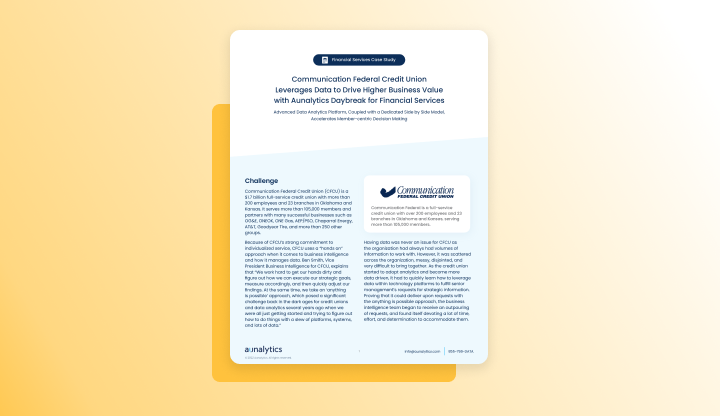Aunalytics’ Client Success Team Drives Measurable Business Value
Transitioning to a more data-driven organization can be a long, complicated journey. A complete digital transformation is more than simply adopting new technologies (though that is an important component.) It requires change at all levels of the business in order to pivot to a more data-enabled, customer-focused mindset. Aunalytics Client Success is committed to helping organizations digitally transform by guiding and assisting them along every step of the journey, and ultimately, allowing them to thrive.
Below, the Client Success (CS) team has answered some of the most common questions about what they do and how they help organizations achieve measurable business outcomes.
What is Client Success?
Aunalytics CS partners with clients to become their trusted advisor, by building a customized CS Partnership Plan utilizing the client’s unique business needs as the core goals. The CS Partnership Plan creates an exceptional client experience by consistently applying a combination of our team and technology to deliver measurable value and business outcomes for our clients.
What are the main goals of the Aunalytics Client Success team?
The Client Success team has four main goals:
- Designing targeted client experiences (by industry, product, and digital transformation stage)
- Recommending targeted next steps by simplifying and synthesizing complex information
- Delivering proactive and strategic support from onboarding to solution launch, ongoing support, and consulting
- Collecting and responding to client feedback on ways our service delivery can evolve
What are the various roles within the CS team?
There are two main roles within the CS team that interact with clients on a regular basis. The first is the Client Success Manager (CSM). The CSM manages day-to-day client tactical needs, providing updates and direction throughout the onboarding process. As the liaison between clients and the Aunalytics team, the CSM synthesizes complex information into clear actions, mitigates any roadblocks that may occur, and clearly communicates project milestones. The CSM works closely with the clients throughout their partnership with Aunalytics, from onboarding, adoption, support, and engagement.
The Client Success Advisor (CSA) works on high-level strategy with each client, translating Aunalytics’ technology solutions into measurable business outcomes. They partner with the clients’ key stakeholders to understand their strategic objectives and create a custom technology roadmap that identifies the specific steps necessary to reach their digital transformation goals. These goals are integrated into the client’s specific CS Partnership Plan to ensure we are aligned on objectives and key results, with clear owners, timelines, and expected outcomes.
How often can a client expect to hear from a CS team member throughout their engagement with Aunalytics?
The CS team is introduced to clients at the initial kickoff meeting and CSMs initiate weekly touch points to ensure onboarding milestones are being met and to communicate action items, responsible parties, and next steps. During these calls the CS team (CS Manager, CS Advisor, Data Engineer, & Business Analyst) will review the project tracker—highlighting recent accomplishments, key priorities, and next steps. Each item is documented, assigned an owner, a timeline, and clear expectations around completion criteria.
What is the Aunalytics “Side-by-Side Support” model and how does the CS team help facilitate this?
Our side-by-side service delivery model provides a dedicated account team, comprised of technology (Data Engineers (DE), Data Scientists (DS), and Business Analysts) and data experts (Product Managers, Data Ingestion Engineers, and Cloud Infrastructure Team), to help transform the way our clients work. The account team collaborates across the company, in service of the client, to ensure that everyone on the team is driving towards the client’s desired outcomes. The CSA captures this information in the CS Partnership Plan to ensure alignment, key priorities, and ownership of time-bound tasks.
The CS team partners with Aunalytics’ Product, Ingestion, and Cloud teams to share client questions, recommendations, and future enhancement ideas. The Partnership Plan is a custom document that evolves with the client’s ever-changing needs. The CSA reviews the Partnership Plan with the client every quarter to capture new goals, document accomplishments, and create feasible timelines for implementation. The goal of the CSA is to create a relationship with the client, in which they view the CSA as a key member of their internal team (e.g. the same side of the table vs. a vendor).
A successful partnership with Aunalytics’ Client Success team is when concrete business outcomes and value are realized by the client, through the use of Aunalytics’ solutions (products + service).
What are some examples of business outcomes that CS has helped Daybreak for Financial Services clients achieve?
In addition to guidance throughout the initial implementation of Daybreak, CS has assisted banks and credit unions with the execution of a number of actionable business cases, such as:
- Assisting Financial Institutions with implementation of self-service analytics programs;
- Improving collection and recovery rates on loans;
- Implementing pattern recognition to make sure that risk and collection departments are efficiently targeting the most at-risk loans;
- Creating data driven marketing programs to offer personalized services, next-best products, and onboarding. Data-driven marketing allows financial institutions to be more efficient with their marketing dollars and track campaign outcomes better;
- Integration with 3rdparty software systems.
The Aunalytics Client Success team is instrumental in helping clients realize measurable business value. Together with Aunalytics’ strong technology stack, this side-by-side delivery model ensures that all clients are equipped with the resources they need to affect positive change within the organization and achieve their digital transformation goals.
Daybreak’s Built-in Industry Intelligence Leads to Faster, More Actionable Insights for Banks and Credit Unions
When choosing a piece of technology for your business, it is important to consider technical specs, features, and performance metrics. But that isn’t all that matters. Even though a product or solution may fit all of your technical requirements, it might not be a great fit for your bank or credit union. As an all-in-one data management and analytics platform, Daybreak is a uniquely strong contender on technical abilities alone, but it also offers features specifically engineered to answer the most prevalent and actionable questions that banks and credit unions currently ask, or should be asking themselves, every day. This is made possible through its built-in industry intelligence.
Industry Intelligence Increases Speed to Insights
Daybreak was developed specifically to help mid-market banks and credit unions compete, leveraging the same big data and analytics technologies and capabilities as the largest, leading institutions in the industry. We know that financial services organizations have a wealth of data—but not all of it is actionable, nor even accessible in its current state. We quickly break down data silos and integrate all the relevant data points from multiple systems; including internal and external, structured and unstructured.
It is Industry Intelligent because our experience knows the kinds of questions an institution needs to answer—that is why over 40% of the data in our model doesn’t exist in the raw customer data. These new data points are called Smart Features.
Over 40% of the data in the Daybreak model doesn’t exist in the raw customer data. It is engineered using Smart Features.
Data Enriched with Smart Features Provides Actionable Insights
One huge advantage that Daybreak offers banks and credit unions is automated data enrichment, through the use of Smart Features. Smart Features are newly calculated data points that didn’t exist before. Daybreak utilizes AI to generate these new data points which allow you to answer more questions about your customers than ever before. For example, Daybreak automatically converts unstructured transactional data into structured Smart Features—converting a long, confusing text string to a transaction category. A transaction that looks like this in the raw data…
| CHASE CREDIT CRD CHECK PYMT SERIAL NUMBER XXXXXXXX |
Is converted to this data point, which can be easily analyzed or used to filter and analyze:
| Customer Number | Account Number | Destination Category | Destination Name | Recurring Payment |
|---|---|---|---|---|
| 123 | 456 | Credit Card | Chase | Yes |
Another category of Smart Features are new values that are calculated based on existing data. For example, Daybreak’s AI scans transactional data and determine which branch is used most often by each individual. It can look at person’s home address and determine which branch is the closest to their home. The AI also scans transactional data for anomalies, and flags any unusual activities, which may indicate a fraud attempt, or a life change. For example, if an account suddenly stops showing direct deposits, perhaps that customer has changed jobs, or is in the process of switching to a different bank.
Since these Smart Features are automatically created, you can start asking actionable questions right away, without waiting for complicated analysis to be performed.
Daybreak has pre-built connectors to most of the major core systems, CRMs, loan and mortgage systems, and other heavily utilized financial industry applications. This means we can get access to your data faster, including granular daily transactional data, and automatically serve it back in a format that you can use to make data-driven decisions. We’ve figured out the difficult foundational part so you don’t have to spend months of development time building a data warehouse from scratch—you will begin getting insights right away.
Daybreak aggregates data from multiple sources, and allows you to receive actionable insights right away.
Scale your Team’s Industry Experience with Daybreak
One challenge that organizations face with any new initiative is how to transfer knowledge and collaborate across departments or locations. If one team member creates a useful analysis or process, it can be difficult to share with others who may want to look at the same type of information. Daybreak’s Query Wizard makes it easy to share intelligence across your business by providing pre-built queries for common banking questions and insights. We also update the pre-built queries regularly with new business-impacting questions as they are formulated. Lastly, in a click of a button, any query is available in SQL code, providing a huge head start to your IT team in more advanced work that they would like to do.
The Daybreak Advantage
Unlike other “one-size-fits-all” technology solutions, Daybreak has financial industry intelligence and AI built into the platform itself. It allows banks and credit unions easy access to relevant data quickly, and without investing excessive time and money to make it happen. With Daybreak, business users have access to actionable data, enriched with Smart Features, in order to start answering impactful questions they’ve never been able to before. Your entire organization can utilize industry-specific insights and collaborate on data analysis.
Daybreak is a game-changer for banks and credit unions. Start making better business decisions by effectively leveraging your data today.
Solving Data Challenges for Mid-Market Community Banks
Mid-market community banks and credit unions are facing increased expectations from customers and members. As technology advances across all industries, people expect a highly-personalized experience. To provide a customized customer journey, banks and credit unions must utilize the wealth of data that is available to them—basic account information, CRM data, transactions, loan data, and other useful sources.
However, this requires an institution to overcome a number of challenges, including siloed data, poor data quality and governance, use of stale, non-actionable data, manual retrospective reporting, and overall lack of necessary analytics tools and talent. Building a strong, scalable, and automated data management foundation is necessary to realize a digital transformation and ultimately meet customer expectations through actionable analytics insights. Thankfully, these challenges are not insurmountable, and we have outlined the various challenges and put forward guiding principles to help your organization overcome them.
Asking the Right Questions, at the Right Time
Having access to data is powerful, but only if you are asking the right questions. Some organizations have hundreds of dashboards, but few of the insights are actionable. Others have specific questions they’d like to answer, but no easy way to create custom queries or visualizations to dig deeper into the data. It is important to arm all users with the tools necessary to analyze data in order to take action. Users need to be given the ability to utilize relevant pre-built queries or build their own, filter data, segment customers and members, and create meaningful lists. This is also dependent on having a strong, centralized data repository, built for analysis, that gives access to timely and accurate data.
Choosing the Right Technology
While modern core systems and other business applications have their uses, they are not equipped to handle enterprise-wide analytics. These databases systems of record and are meant to handle transactions, and while ideal for collecting and modifying records in real-time, they are not able to meet the needs of querying and analytics. Furthermore, when data is spread across multiple systems, there must be a central repository to aggregate all of this data. A cloud-based next-gen data lake or data warehouse is the ideal option in this situation. They are easily queried and the structure lends itself to analytical applications, including machine learning, predictive analytics, and AI. By building a strong foundation, for BI and analytics, community banks and credit unions make a huge leap towards digital transformation and more closely competing with their larger industry peers.
Breaking Down Data Silos
Financial institutions have no shortage of data. However, that data is usually siloed across many systems throughout the organization. Aggregating and integrating that data is a major challenge that in the best case scenario, can be difficult and time-consuming, and at worst, nearly impossible (such as with transactional data). It can be especially challenging when working with vendor-hosted systems, such as your core, mortgage, loan origination, mobile/online banking, and CRMs. All of this data offers key details into customer behavior, so it is important to utilize all sources to get a complete picture of individuals, as well as the institution as a whole. This is why a singular data warehouse or data lake is essential for analysis and reporting. When all the data from various sources is ingested into this system, via internal connectors and external APIs, it is far easier to query and link the data to gain a 360-degree view of each customer or member, and discover insights you’ve never had access to before.
Ensuring Data Accuracy
Having a wealth of data and insights at your fingertips is only helpful if that data is accurate. Whenever data is entered into a system manually, it is an opportunity for mistakes to be made. If a name is misspelled in one system, it may not be obvious that it is referring to the same person in another system. Valuable insights into that individual’s behavior may be lost. On the other hand, if, in the course of ingesting data from an outside system, there is an error, would it be easy to detect the data loss? One way to mitigate these scenarios is to implement quality assurance technology and best practices. In this way, data discrepancies can more easily be detected and flagged for correction. To take it a step further, data preparation automation tools can be used to correct common mistakes as the data is ingested into the platform.
Using Timely Data
There is nothing worse than making decisions based on stale data. Circumstances can change rapidly, and the ability to be proactive in customer and member relationships is key to providing the personalized experience they have come to expect. For example, if a customer is showing signs of potential churn, banks and credit unions need to know as soon as possible in order to intervene. Transactional databases are changing daily, so it is important to establish a system by which the foundational data repository is updated regularly. For this situation, automation is essential. Manually ingesting data on a daily basis is time-consuming and can be unrealistic for many community banks and credit unions. However, utilizing automated data ingestion and preparation ensures that the data will be updated as often as necessary, with minimal to no human intervention required.
Acquiring the Necessary Talent
Developing a foundational analytics platform is no easy task. It can take huge amounts of time and effort to build an analytics-ready data warehouse from scratch. From planning and strategizing, to actual execution, it can take many months just to get started with any BI or analytics initiative. In addition, it can be challenging, and costly, to recruit and hire data engineers, analysts, and data scientists to run and develop custom algorithms. One way that mid-market financial institutions can save time and effort is to utilize a data platform built specifically for the unique challenges of the banking industry to accelerate the development process. A product that also allows you to utilize pre-built queries, algorithms, and dashboards can also shorten the time to deployment and, ultimately, insights.
Granting Access to All Who Need It
Once the data is compiled, it can be a challenge to get it into the hands of decision-makers across the organization. Will people access data through dashboards? Do they need raw data to perform deeper analysis? Will everyone have access to all data, or will some only need a smaller subset? Using a tool that gives users the ability to interact with data in a variety of ways, be it through code or visualizations, and that gives varying levels of access, is key to managing corporate data governance. Having a centralized data repository also ensures that all users are interacting with the latest, most accurate data.
Daybreak: A Complete Solution for Banks and Credit Unions
While there are a number of challenges to overcome in becoming more customer- or member-centric, it all begins with a strong data foundation. That is why Aunalytics has developed Daybreak, an industry intelligent data model that gives banks and credit unions easy access to relevant, timely data and insights, as the sun rises. Daybreak is an all-in-one analytics solution that automates key tasks—data ingestion across multiple disparate sources, data transformation and preparation, and quality assurance practices—built on a secure, powerful cloud-based data platform, to ensure data is always up-to-date, accurate, and accessible across your organization. It also allows users to connect to any outside source, visualization, or BI tool of choice, or they can leverage Daybreak’s user-friendly, guided Query Wizard and SQL builder interfaces to get to actionable insights.
With Daybreak, anyone across your organization can gain a deeper understanding of individual customers and members, while also acquiring a high-level understanding of the business as a whole. With access to the right data, at the right time, your institution can make better business decisions, faster.
Bank Jumpstarts Journey to Predictive Analytics & AI
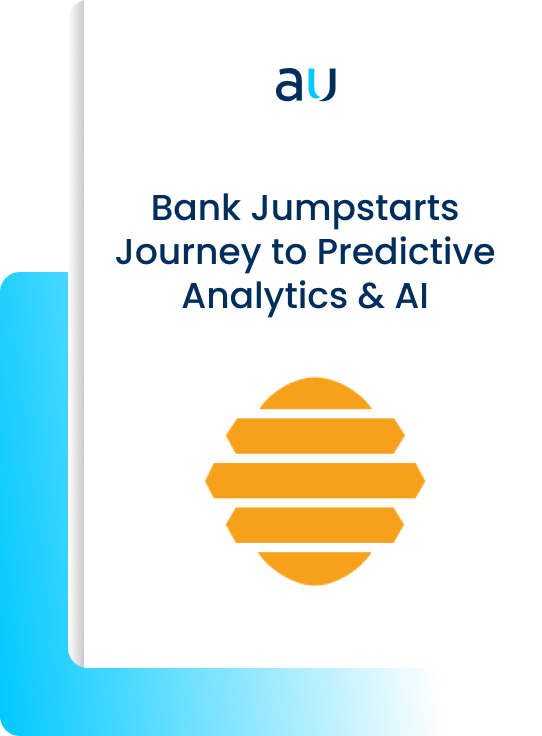
Bank Jumpstarts Journey to Predictive Analytics & AI
Provident Bank, a mid-sized bank with $10 billion in assets, is the oldest community bank in New Jersey with branches across two states. Although they have successfully met their customer’s needs for more than 180 years, they knew that they needed to invest in technologies today that would carry them into the future.


